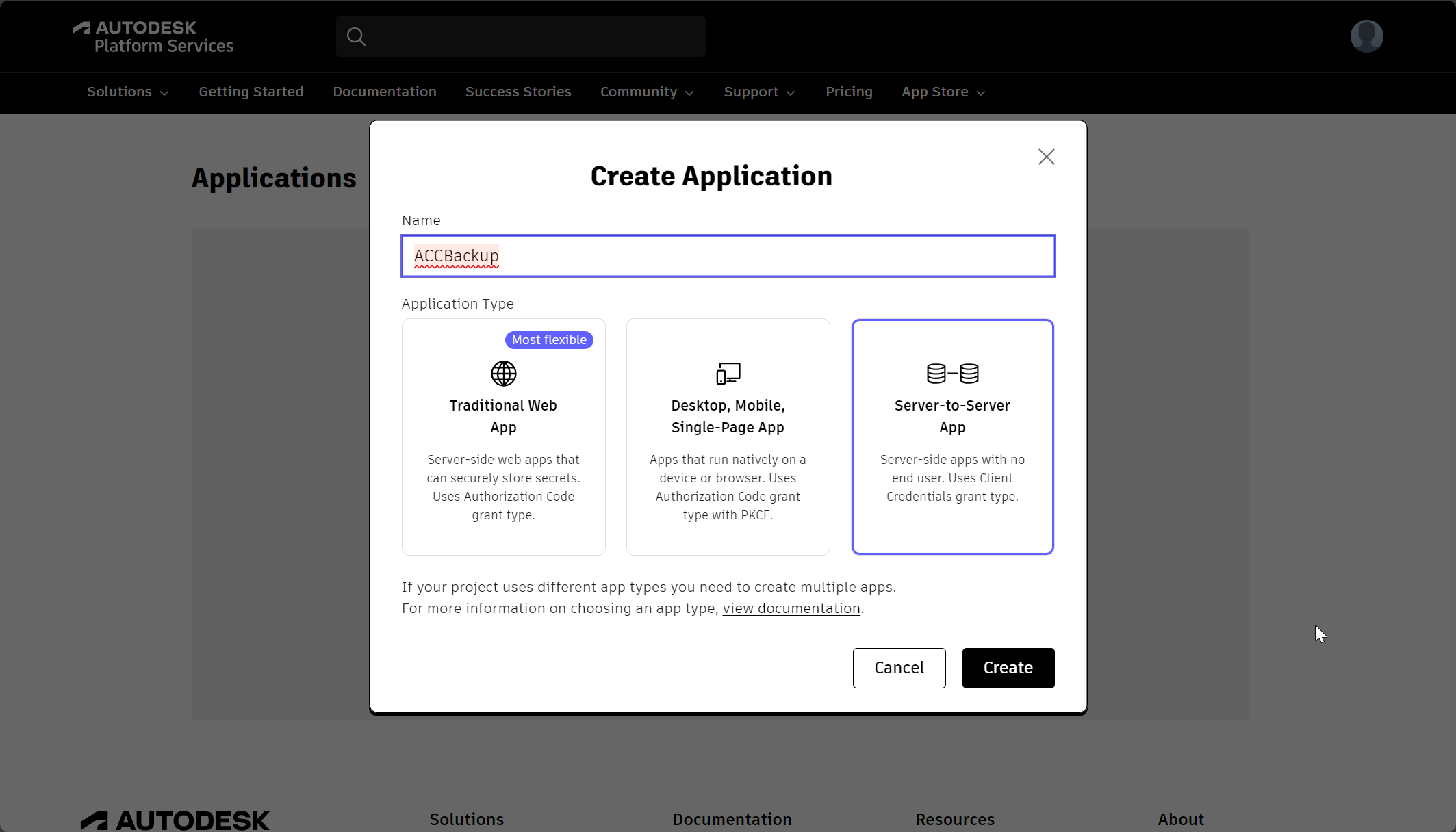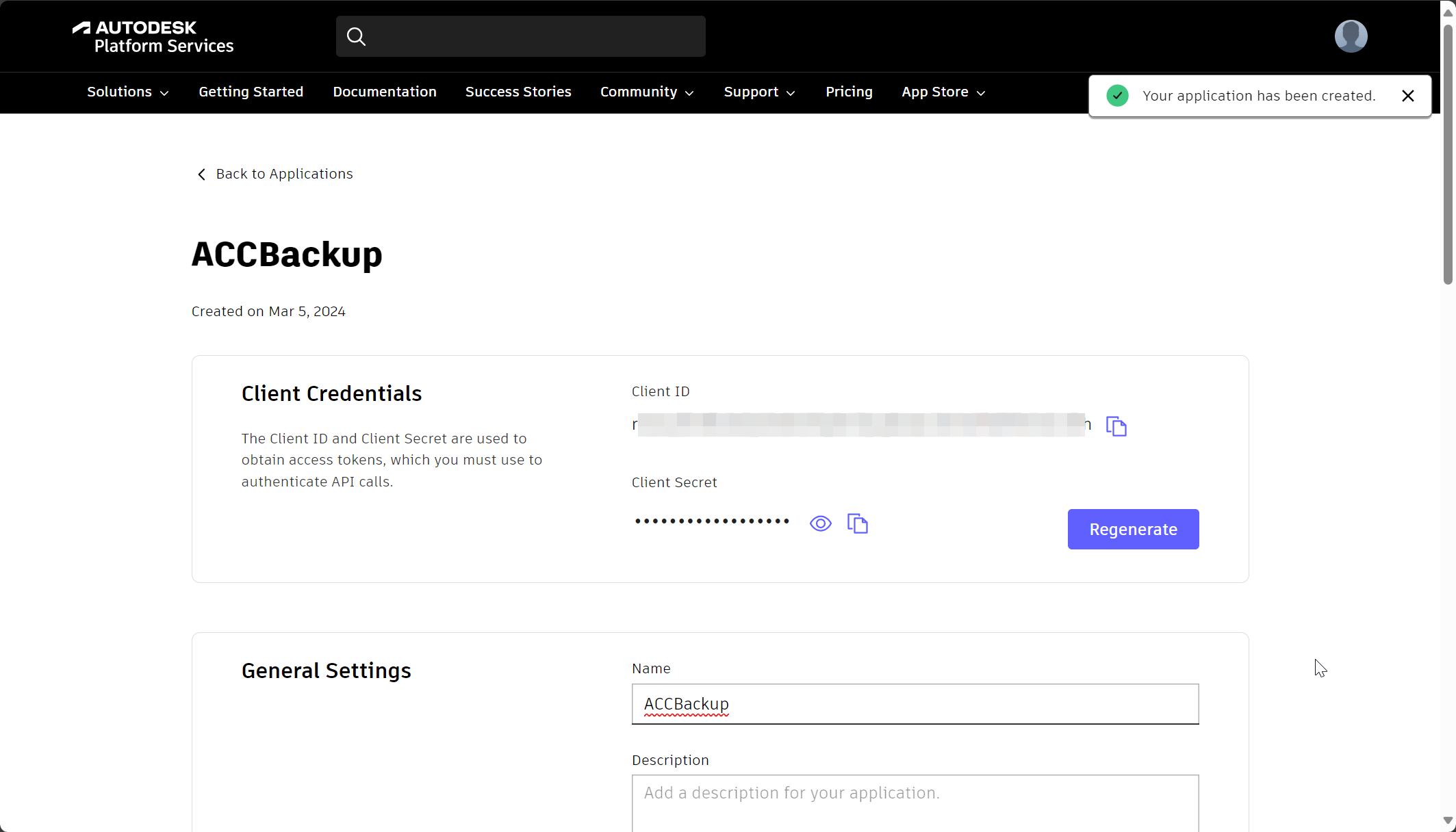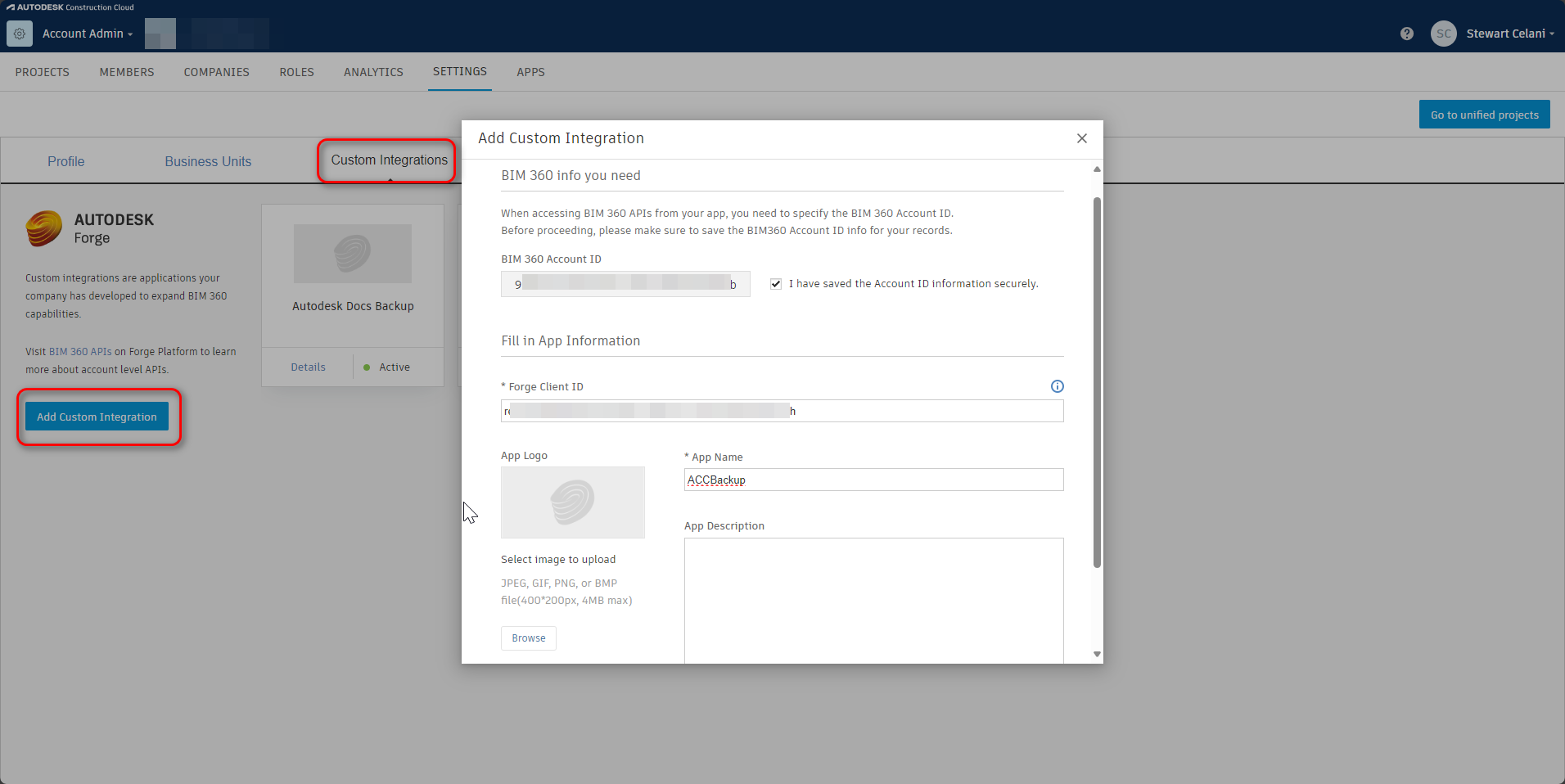ACCBackup is a C# console application built to backup all Autodesk Construction Cloud/BIM360 projects in your account via Autodesk Platform Services (formerly Autodesk Forge).
It can be run as a one-off or scheduled via a script. It was designed to fulfill a need that Veeam Backup didn't support. The only products on the market at the time were $6k AUD per year, took 15-20 hours to backup what ACCBackup does in 3 hours, and required each project to be manually configured as a separate task/job.
By default, ACCBackup will backup all projects in your account.
Update 06/03/2024: Since initial release in May 2022 I've been using ACCBackup to run nightly backups of (now) 150~ projects @ 200 GB~ in 6 hours without issues.
- Create an app via https://aps.autodesk.com/myapps/. At the time of writing all the APIs the app we are creating will use are free.



- Make sure to only select the following two APIs:
Autodesk Construction Cloud API,Data Management API
- Save the
Client IDandClient Secretas you will need them for the backup. - Enable Custom Integrations on your Autodesk admin account (if you don't see the tab email autodesk support as this article describes -- just say you want to build a custom integration).
- From Accounts Admin -> Settings -> Custom Integrations -> Add Custom Integration -> provide Client ID and App Name. Save the
BIM 360 Account IDas you will need that for the backup.
- Once this is done you will have a forge app with
Client ID&Client Secretthat will be approved for yourBIM 360 Account ID.
- Install latest .NET Runtime 8.X.X -- only the console version is required ("The .NET Runtime contains just the components needed to run a console app. Typically, you'd also install either the ASP.NET Core Runtime or .NET Desktop Runtime.")
- Download the .zip via the releases tab
- Unzip and run (see examples below)
ACCBackup.exe --help
--backupdirectory Required. Backup directory.
--clientid Required. Client ID of Autodesk Forge app.
--clientsecret Required. Client secret of Autodesk Forge app.
--accountid Required. Autodesk Construction Cloud account ID.
--hubid Autodesk Construction Cloud HubId, defaults to b.AccountId. See
https://forge.autodesk.com/en/docs/data/v2/reference/http/hubs-hub_id-projects-project_id-
GET/ for more information.
--maxdegreeofparallelism (Default: 8) Number of files to download in parallel.
--retryattempts (Default: 15) Amount of times to retry when there are errors communicating with the
Autodesk API.
--initialretryinseconds (Default: 2) Each subsequent retry is RetryAttempt# * InitialRetryInSeconds. Default
settings of 15 RetryAttempts with InitialRetryInSeconds 2 totals 4 minutes of retrying.
--dryrun (Default: false) Backup will only create 0 byte placeholder files instead of downloading
them, will still create full file structure.
--backupstorotate (Default: 1) Number of backups to to maintain.
--projectstobackup Comma separated list of project names OR project ids to backup. If none given, all projects will be
backed up.
--projectstoexclude Comma separated list of project names OR project ids to exclude from the backup. Takes priority over
'projectstobackup'.
--debuglogging (Default: false) Enable debug logging. Verbose.
--tracelogging (Default: false) Enable trace logging. Extremely verbose.
--smtpport (Default: 25) Backup summary notification email: SMTP port.
--smtphost Backup summary notification email: SMTP server name.
--smtpfromaddress Backup summary notification email: SMTP from address.
--smtpfromname Backup summary notification email: SMTP from name.
--smtptoaddress Backup summary notification email: SMTP to address.
--smtpusername Backup summary notification email: SMTP username.
--smtppassword Backup summary notification email: SMTP password.
--smtpenablessl (Default: false) Backup summary notification email: SMTP over SSL.
--help Display this help screen.
--version Display version information.
Basic:
ACCBackup.exe --backupdirectory "C:\ACCBackup" --clientid "DRO4zxzt71HCkL34cn2tAUSRS0OQGaRT" --clientsecret "tFRHKhuIrGQUi5d3" --accountid "9b3cc923-d920-4fee-ae91-5e9c8e4040rb"
Basic with email summary:
-ACCBackup.exe -backupdirectory "C:\ACCBackup" --clientid "DRO4zxzt71HCkL34cn2tAUSRS0OQGaRT" --clientsecret "tFRHKhuIrGQUi5d3" --accountid "9b3cc923-d920-4fee-ae91-5e9c8e4040rb" --smtphost "smtp.yourlocalnetwork.dc" --smtpfromaddress "noreply@example.com" --smtpfromname "ACCBackup" --smtptoaddress "me@stewartcelani.com"
Example of a daily backup with 5 daily backup folders rotating:
ACCBackup.exe --backupdirectory "C:\ACCBackup\Daily" --clientid "DRO4zxzt71HCkL34cn2tAUSRS0OQGaRT" --clientsecret "tFRHKhuIrGQUi5d3" --accountid "9b3cc923-d920-4fee-ae91-5e9c8e4040rb" --backupstorotate 5
Example of a weekly backup with 4 weekly backup folders rotating:
ACCBackup.exe --backupdirectory "C:\ACCBackup\Weekly" --clientid "DRO4zxzt71HCkL34cn2tAUSRS0OQGaRT" --clientsecret "tFRHKhuIrGQUi5d3" --accountid "9b3cc923-d920-4fee-ae91-5e9c8e4040rb" --backupstorotate 4
Example of a monthly backup with 12 monthly backup folders rotating:
ACCBackup.exe --backupdirectory "C:\ACCBackup\Monthly" --clientid "DRO4zxzt71HCkL34cn2tAUSRS0OQGaRT" --clientsecret "tFRHKhuIrGQUi5d3" --accountid "9b3cc923-d920-4fee-ae91-5e9c8e4040rb" --backupstorotate 12
Example backing up two projects (you can use project name or project id, as project name can change it is recommended to use project id)
ACCBackup.exe --projectstobackup "Test Project, 7468066c-53e6-4acf-8086-6b5fce0048d6" --backupdirectory "C:\ACCBackup" --clientid "DRO4zxzt71HCkL34cn2tAUSRS0OQGaRT" --clientsecret "tFRHKhuIrGQUi5d3" --accountid "9b3cc923-d920-4fee-ae91-5e9c8e4040rb"
Example backing all projects BUT two projects
ACCBackup.exe --projectstoexclude "Test Project, 7468066c-53e6-4acf-8086-6b5fce0048d6" --backupdirectory "C:\ACCBackup" --clientid "DRO4zxzt71HCkL34cn2tAUSRS0OQGaRT" --clientsecret "tFRHKhuIrGQUi5d3" --accountid "9b3cc923-d920-4fee-ae91-5e9c8e4040rb"
- Log files are located in ACCBackup.exe\Logs
- Try running with --hubid "YourAccoundIdHere" OR --hubid "b.YourAccountIdHere" (Autodesk is migrating from BIM360 to 'Autodesk Construction Cloud' but internally, at the moment, the API hubid needs b.AccountId (b. = BIM360).
- First step is to run with the --debuglogging flag
- If the --debuglogging flag doesn't point you in the right direction the --tracelogging flag should be used.
- If all else fails log an issue via the repo with a link to your --tracelogginng log file and I will investigate.
- Or/and email bold.oil7762@fastmail.com with your log file attached.
ACCBackup is designed around an ApiClient class library I wrote that does all the heavy lifting. This makes it very easy for you to take the class library and do your own thing with it if needed. Below is a copy of ApiClient.UsageExample:Program.cs
using ACC.ApiClient;
using ACC.ApiClient.Entities;
using Library.Logger;
using Library.SecretsManager;
using File = ACC.ApiClient.Entities.File;
using LogLevel = Library.Logger.LogLevel;
/*
* Required parameters
*/
string clientId = SecretsManager.GetEnvironmentVariableOrDefaultTo("acc:clientid", "InvalidClientId");
string clientSecret = SecretsManager.GetEnvironmentVariableOrDefaultTo("acc:clientsecret", "InvalidClientSecret");
string accountId = SecretsManager.GetEnvironmentVariableOrDefaultTo("acc:accountid", "InvalidAccountId");
/*
* Building ApiClient with default parameters
*/
ApiClient defaultApiClient = TwoLeggedApiClient
.Configure()
.WithClientId(clientId)
.AndClientSecret(clientSecret)
.ForAccount(accountId)
.Create();
/*
* Building ApiClient with all options set
*/
ApiClient client = TwoLeggedApiClient
.Configure()
.WithClientId(clientId)
.AndClientSecret(clientSecret)
.ForAccount(accountId)
.WithOptions(options =>
{
options.HubId = $"b.{accountId}";
options.HttpClient = new HttpClient();
options.DryRun = false;
options.Logger = new NLogLogger(new NLogLoggerConfiguration()
{
LogLevel = LogLevel.Trace,
LogToConsole = true,
LogToFile = true
});
options.RetryAttempts = 1;
options.InitialRetryInSeconds = 2;
})
.Create();
/*
* Getting all projects with above ApiClient
*/
List<Project> projects = await client.GetProjects();
foreach (Project p in projects)
{
Console.WriteLine(p.Name);
}
/*
* Get project by ID
*/
Project project = await client.GetProject("projectIdGoesHere");
/*
* Load root folder contents
*/
await project.GetRootFolder();
foreach (File f in project.RootFolder.Files)
{
Console.WriteLine(f.Name);
}
foreach (Folder f in project.RootFolder.Subfolders)
{
Console.WriteLine(f.Name);
}
/*
* GetContents or GetContentsRecursively can be called on any folder
*/
await project.RootFolder.Subfolders[0].GetContents();
await project.RootFolder.Subfolders[1].GetContentsRecursively();
/*
* GetContentsRecursively can be called directly on a project to enumerate a projects entire directory structure.
*/
await project.GetContentsRecursively();
/*
* Once the contents are loaded into memory they can be downloaded
*/
await project.DownloadContentsRecursively(@"C:\ExampleBackupDirectory");
/*
* Folders can be downloaded by themselves...
*/
await project.RootFolder.Subfolders[0].DownloadContents(@"C:\ExampleBackupDirectory");
/*
* ...or recursively. Remember to enumerate contents before recursively downloading.
*/
await project.RootFolder.Subfolders[0].GetContentsRecursively();
await project.RootFolder.Subfolders[0].DownloadContentsRecursively(@"C:\ExampleBackupDirectory");
/*
* Example of how to get all projects then back them all up
*/
List<Project> allProjects = await client.GetProjects();
var downloadRoot = @"C:\ExampleBackupDirectory";
foreach (Project p in allProjects)
{
await p.GetContentsRecursively();
await p.DownloadContentsRecursively(Path.Combine(downloadRoot, p.Name));
}